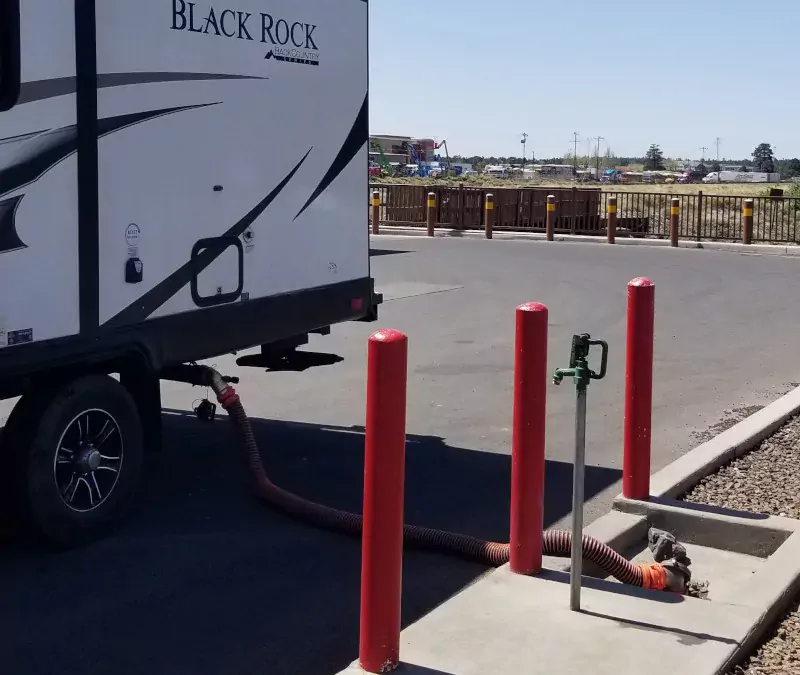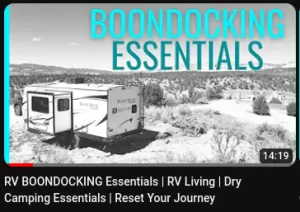Last Updated on 05/10/2024 by Glynn Willard
What Is A Gray Water Tank
Your RV’s sewer system is divided into two different holding tanks.
There’s a gray tank and a black tank. Your toilet water is distributed to the black tank.
The water from your kitchen sink, bathroom sink and shower drains to your grey tank.
Besides the tanks, the actual plumbing in an RV is basically the same as in your home, just on a different scale.
In this article, I’ll go over:
- The three types of RV tanks.
- How to manage your grey water tank (and black).
- Best practices for your grey tank.
- Managing your holding tanks while boondocked and with full hookups.
What Is A Grey Water Tank?
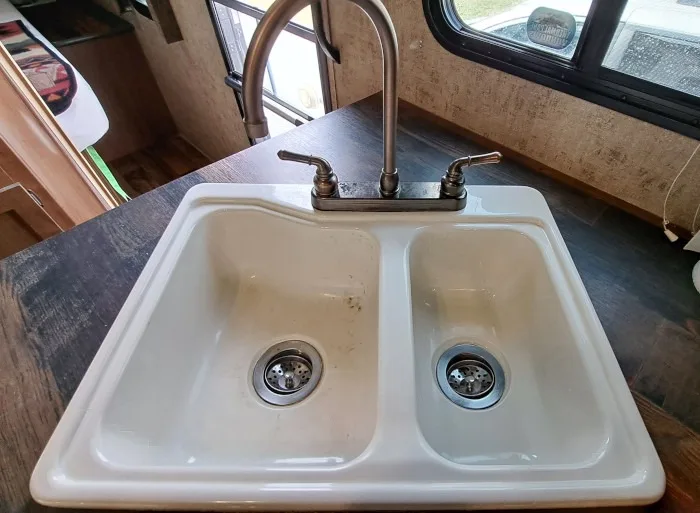
The gray tank stores your waste water from the sinks and your shower water in your RV.
Gray water contains soapy water, food particles, toothpaste and other cleansers. And yes, it has a foul odor.
In other words, it’s dirty water. That’s why I’m against dumping just any grey water on BLM land (if legal).
But I have a solution for that further in the article.
If you have a larger recreational vehicle, it might have two grey water tanks.
What Is A Black Water Tank?
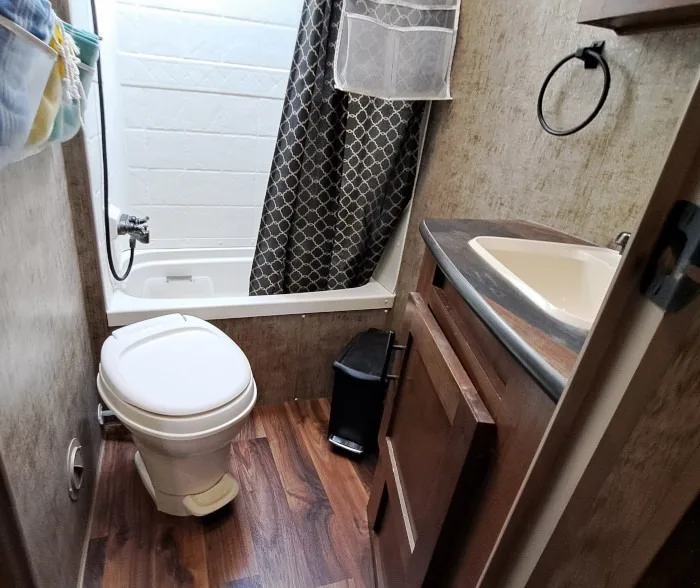
The RV black tank is reserved only for the toilet disposal.
It’s where the flushed toilet water and human waste goes for storage until you dump your RV tanks.
Yes it smells bad and is not a pleasure to work with!
And I will maintain my stance that RV toilet paper should go into a flip-up lid trash container.
Not into the black tank. Many will disagree, but I like using regular TP and this practice eliminates the potential issues that occur when placing TP in the black tank.
For more info, you can dive into our article: RV Toilet Paper: Should It Go In The Black Tank?
But the black tank is not the focus of this article.
Although I will list some best practices for your RV’s sewer system later in the article.
What Is A Fresh Water Tank?
A freshwater tank is just what it sounds like.
It’s where your store the potable water that’s pumped to your faucets.
RV’s come with different sized fresh water tanks. Large class A motor homes, fifth wheels and toy haulers have the largest fresh tanks.
Most travel trailers and vans have small tanks unless it’s designed for boondocking.
We love and prefer boondocking, so we require the largest fresh water tanks available.
Our travel trailer that we sold had the capacity to carry 80 gallons of water and we still carry Scepter cans for additional water.
The campervan we currently own, has 37 gallons of freshwater capacity. That’s high for a van, but still not enough.
Again, the freshwater tank is not the focus of this article, making this enough of an explanation.
If you want to learn more, dive into our article: How To Sanitize RV Water Tank and How Much Water Do You Need While Boondocking?
How To Manage A Gray Water Tank
It’s best to allow your grey water tank to fill as much as possible before dumping.
This allows both a higher volume of water for participates to dissolve and a larger bolus of water to flush the sewer hose.
Minimize the amount of food particles that go down your sink by wiping excess food particles into the trash.
Also, make sure you use your clean out (if you have one) on a regular basis.
There are a few other tips I list later in the articlr in the best practices section for the sewer systems maintenance, management and prevention of unpleasant odors.
RV Dump Station
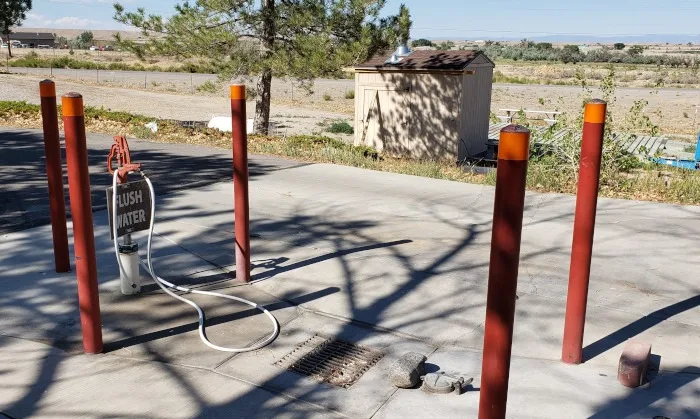
RV dump stations are found at some truck stops, rest areas, municipalities, campgrounds, RV parks, gas stations and casinos.
Note that the locations listed don’t all have a dump station.
They’re more pervasive in the west than the east (sadly).
States like Idaho even have them randomly located along primary and secondary roads. Gotta love Idaho!
On a side note, If it’s your first time dumping an RV, at least remember one thing: dump your black tank first.
Then use the gray tank water to flush the sewer connection.
For more information about how to find dump stations, dive into our article: How To find RV Dump Stations.
Not Sure What You Need For Your RV?
Best Practices Managing Your RV Sewer System
There are a few things RV owners can do to make their life easier when dealing with the grey water tank:
- Wipe greasy foods off your dishes before washing them in the RV’s kitchen sink.
- Use a biodegradable soap.
- Catch your dish water and shower water in a bin and use it to extinguish your camp fire.
- When boondocking, catch “clean” grey water (hand washing and shower water) and toss it if it’s not excessively soapy water. This will buy more time before having to dump your tanks.
For the sake of the environment, let your dishwater go down the sink drains. Make sure you trickle the water to save both the grey and fresh water tank. - If you live full time in your RV, approximately once a month, pour about a cup of borax down your drain before the tank is full.
This will elevate the pH and “soften” the particles in the grey tank, making for an easier flush. - Allow your gray tank to fill up as much as possible prior to dumping. This allows for a large bolus of water to flush the sewer pipe clean after dumping the black tank.
- When connected to full hook ups, keep your gray tank valve and black tank valve shut until you’re tanks are at least half full.

Leaving your dump valves open can lead to food sticking to the walls and bottom inside the tank as well as the potential for a “poop pyramid.” - Again, always dump your black tank first, so that the gray tank flushes the drain hose.
- If your RV is equipped with a clean out, use it on a regular basis. Just make sure you leave your gate valve open.
If your RV doesn’t have a clean out, some sewer hoses have a nozzle attachment to fire water into the waste tanks. It’s worth using. - Get to know your water usage and time period it takes to fill your waste water tanks. Your tank sensors are not accurate and will likely stop working after a short while.
- If you have access to the to the plumbing to and from your tanks, check your connections to make sure they’re tight on occasion.
Plumbing on an RV can loosen easily if you move a lot. Ask me how I know!

Our P-trap came loose from frequent travel and leaked under the shower. Easy fix!
A few other notes:
If you’re staying in a campground with a dump station rather than a sewer on your site, you can use a portable tank.
A portable tank allows you to dump your tanks into the portable tank and either tow or push it (it has wheels) to the dump station.
This allows you to remain in your site without packing up your whole rig just to dump your tanks.
If that’s your style of RV camping, it’s a good idea to invest in a portable tank.
Note, if your RV has a macerator, you’ll use a designated garden hose instead of a standard sewer hose to dump your RV tanks.
Wrapping Up An RV’s Grey Tank
Whether you plan on boondocking exclusively or staying in RV parks, being self contained is essential.
Therefore, you need your gray tank working proficiently (and your black tank).
Keep it flushed, use borax on occasion and use your clean out on a regular basis.
When releasing your gate valve to dump your tanks, be gentle. They can break easily.
If you have access to the to the plumbing to and from your tanks, occasionally check your connections to make sure they’re tight.
That’s about all you can do to keep your grey tank maintained.
How do you maintain proper maintenance of your RV’s gray tank?
Meet the author.
We appreciate any help to bring you great content. Donate or buy us a coffee on our Ko-Fi site. Or subscribe to our YouTube Channel. Thank you so much for being here!


